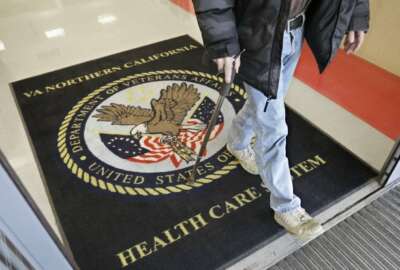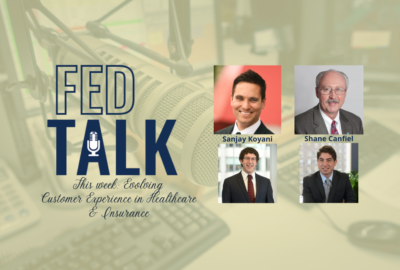Hubbard Radio Washington DC, LLC. All rights reserved. This website is not intended for users located within the European Economic Area.
Agencies slightly improve customer experience, but still behind the private sector
Customer experience from government agencies has a long way to go. That's the principal finding in the latest survey by Forrester Research.
Best listening experience is on Chrome, Firefox or Safari. Subscribe to Federal Drive’s daily audio interviews on Apple Podcasts or PodcastOne.
Customer experience from government agencies has a long way to go. That’s the principal finding in the latest survey by Forrester Research. It found CX has improved slightly, but it still lags behind the best of the private sector. For more, Federal Drive with Tom Temin turned to Forrester Vice President and Principal Analyst Rick Parrish.
Interview transcript:
Tom Temin: Rick, good to have you back.
Rick Parrish: Thanks, good to be here.
Tom Temin: Just review for us how you determine these scores each year. And then we’ll get into some of the details.
Rick Parrish: Sure, these results come from what we call our customer experience index, or CX index. And it’s a survey of tens of thousands of customers of organizations in both government and the private sector – nearly 300 organizations, actually, from around the country, and in fact, several other countries around the world. And what we do is we ask them a battery of questions about the experiences that they have with organizations that they deal with. And we use that to, among other things, determine a top line score of between 0-100, which measures not only the quality of the customer experience, but the degree to which that customer experience helps in the case of government organizations helps government organizations achieve their own mission success through the quality of the customer experience.
Tom Temin: And what did you find this year with respect to the government on average, between that 0-100?
Rick Parrish: What we found was among the 15 US federal agencies and programs that we study, we found an average score of 61.1 out of 100, which is up by 1.4 points from 2019. So 2019, the average was 59.7 out of 100, this year at 61.1. So plenty of headroom still to go there, but positive movement, you know, in a good direction. And so I’m happy about that.
Tom Temin: And the range of agencies is actually much wider, who did the best among the federal agencies?
Rick Parrish: Once again, the National Park Service scored highest in federal space, that’s a score of 77.2 out of 100. And they were one of the five agencies that did improve year over year. So National Park Service is the top and once again, USAJobs.gov at the bottom of the federal rankings – indeed, the bottom of the entire US customer experience index overall, with a score of 46.9.
Tom Temin: Now is it significant that the Park Service is really a bundle of experiences? They do have online reservations for their facilities, lots of other online resources. But of course, it’s a tactile real world place that you visit, and encounter parking lots, gift shops, ranger stations, visitor centers, all of those places. And so the customer experience is really both online and in person. Whereas USAJobs is just a terrible website.
Rick Parrish: Well, it’s mostly significant insofar as the National Park Service is really great at integrating those multiple experiences across not just itself, but a complex ecosystem of vendors and contractors and subcontractors. Of course, many of the interactions that people have in a national park experience aren’t even with actual National Park Service employees. Oftentimes, you know, if you go into a gift shop, there’s a local contractor there. If you stay in a hotel, or even a restaurant, that’s going to be a different contractor – to say nothing of the various associated .orgs and things like that. And so this actually just makes it all the more impressive that the National Park Service is able to stay at the top of the federal rankings because this is a complex ecosystem of organizations. And as you say, touchpoints and channels that form the National Park Service experience. It’s one of those things that you don’t notice until it breaks, but it tends to work quite smoothly. And so there’s actually a lot that the private sector could learn from the relatively smooth way that the National Park Service is able to incorporate all of that stuff. Versus say USAJobs at the bottom as you say, there’s just a website that has plenty of room for improvement. But of course, the thing is that people who go to USAJobs want to have just as good an experience there as they do when they visit a national park. And so it’s a relatively simpler ecosystem of interactions with USAJobs.gov. But they are having to wrangle a lot of stuff across a lot of federal agencies. So behind the scenes, there’s a lot goes on there too, that they’ve got to herd those cats behind the scenes in order to make that website work. So it’s very different from the National Park Service, but I wouldn’t necessarily say it’s radically easier, but certainly as we see the experience with USAJobs.gov is weaker than the one at National Park Service.
Tom Temin: We’re speaking with Rick Parrish. He’s vice president and principal analyst at Forrester Research, and you mentioned the average federal score of 61.1 out of 100. How does that compare with the private sector?
Rick Parrish: So the federal average is 10.7 points behind the private sector average. So federal average is 61.1 – 10.7 points behind the private sector. And the top brands in the private sector, really at the top of the whole CX index are brands, like USAA – the financial services provider – their Navy Federal Credit Union, Zappos, Lexus, Barnes and Noble. Companies like that are up at the top end well above the National Park Service at the top of the federal average, the ultimate high score this year is USAA’s credit card business with a score of 83.9. So when you consider that that’s out of 100, though, still some room to improve there.
Tom Temin: The implication here is that serious management attention is required. As we talked about, say the orchestration required by the USAJobs to get everything working within this website, which is a portal to many, many services versus the Park Service, which is also a kind of conglomeration of many, many elements. It sounds like attention to the final effect is really what’s important here, and not so much how much you have to juggle.
Rick Parrish: Yes, that’s really the key here is that the government needs more outside-in thinking, customer-centric thinking. That’s what leads to a better customer experience when you really focus on operating and planning and managing and prioritizing from the outside in. Because ultimately, the goal here is to create a better customer experience. And you can’t do that if you’re focused on traditional internal operational stuff. But of course, the potential problem even with outside-in thinking in government is that in a lot of places in government, even where we do see improvement, we still see a real struggle between the feds who really – they really get it, they really understand what it takes to improve the customer experience, versus those feds who think they get it, but really just think that if you throw more resources at the problem, that’s what’s going to do it. This isn’t about volume of resources. This isn’t about number of projects, this is about focusing on the stuff that matters, and ignoring the stuff that doesn’t. And so, I like to think of it as kind of a work smarter, not harder kind of scenario. It does take management attention. But it takes management attention, on the right things, not on doing more things.
Tom Temin: And also to some extent, it requires the right technology base to support things like digital services. I’m thinking of the IRS, which ranks pretty well down there. They have a very old technology base that they’re trying to modernize. And one of the reasons they want to modernize it is because they know they need to improve their customer experience, which includes the ability of one operator speaking to one tax payer to be able to see the entire picture for that tax payer, which they often cannot do now.
Rick Parrish: Absolutely. There are some very customer focused people at IRS, but they’re trying to pull along of very aged technology infrastructure, as you say, with the very complex, very inertia-ridden ecosystem. And that’s very difficult. That’s why this is the work of years and years. There are no quick fixes here, even on the technology front. But yes, technology is an essential key here behind the scenes, as you say for things like systems that make sure that employees can understand the taxpayer’s history or history of contact, his/her taxpaying history, etc. Even things as simple as what was the reason for their previous call is this – is this the same problem or a new problem? Very simple information like that, that is very common to have in the private sector. Government organizations find this very difficult to gather and to retain, because they tend not to have the technologies available to do it. Of course, technology also plays a role on the front end. The interaction layer, if you will, with customers interacting with federal agencies. And of course, especially these days, digital is more and more the thing. The trick here is that when federal agencies tend to design digital channels for customers to use, they tend to take a very traditional approach to digital design, which doesn’t actually take into account the quality of the customer experience. Now there are places where this is not true. There are some quite good government digital experiences. But by and large, their approach to digital interactions with customers tends to be very traditional one that doesn’t really focus on improving the quality of the experience.
Tom Temin: All right, so there’s homework then?
Rick Parrish: Plenty.
Tom Temin: Rick Parrish is vice president and principal analyst at Forrester Research. Thanks so much.
Rick Parrish: Good to be with you.
Tom Temin: We’ll post this interview along with a link to his blog at FederalNewsNetwork.com/FederalDrive. Subscribe to the Federal Drive at Apple Podcasts or Podcastone.
Copyright © 2024 Federal News Network. All rights reserved. This website is not intended for users located within the European Economic Area.
Tom Temin
Tom Temin is host of the Federal Drive and has been providing insight on federal technology and management issues for more than 30 years.
Follow @tteminWFED
Related Stories




